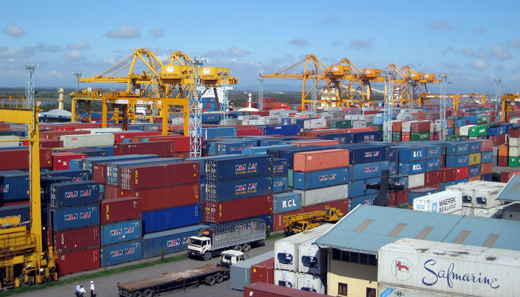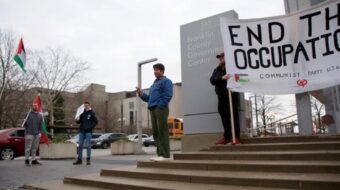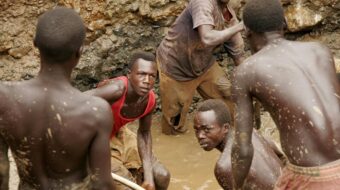
HO CHI MINH CITY – Vietnam is a beehive of activity. To a visitor, this nation seems to be bursting with energy and hurtling from underdeveloped status to modernization overnight. The country is now 30 years into a program of massive economic and political changes called “renewal”, (or Doi Moi) launched in 1986. Renewal overlapped the last 20 years with restored diplomatic and economic relations with the U.S., now the country’s leading trade partner.
The renewal reforms scrapped the Soviet-style economic model of centralization and collectivized agriculture in favor of what is referred to as a socialist-oriented market economy. Integration into the global economy has accompanied the changes.
What Vietnam has achieved since then is nothing short of astounding. Economic growth over the last ten years has averaged 6.7 percent annually while poverty has been reduced from 58 percent to 7 percent.
These achievements have been won against great odds. Vietnam endured 1,000 years of domination by the Chinese, 100 years of anti-colonial struggle against France and Japan, plus the brutal 20-year war against U.S. aggression that left 3 million dead and the country in ruins. Next came a postwar economic boycott, a war with Cambodia on its southwest border in 1978, and a military conflict with China in defense of its northern border in 1979. And if that wasn’t enough, it survived the collapse of socialism in the Soviet Union and Eastern Europe.
The legacy costs of the American war remain daunting. Allocations to war victims, veterans, and environmental restoration make up 25 percent of the national budget. On top of this, Vietnam must also address the growing needs of its population, which has doubled since 1970. It must keep up with the galloping scientific and technological revolution and respond to grave threats from climate change.
Things had to change
The Vietnamese adopted the Soviet-style socialist model of central planning and total public ownership in the 1950s. It served them well during the “American War” of aggression, helping to mobilize the nation’s scant resources for victory.
But life was extremely tough and often desperate. Throughout the period stretching from the 1950s to the 1980s, they relied heavily on Soviet aid. The wartime 1960s and 70s were periods of constant food shortages. A popular joke at the time went like this: Vietnamese government cables Moscow: “severe shortages, send food.” Moscow responds: “tighten belt.” Hanoi responds: “send belts.”
But once the war for independence ended and the country turned to rebuilding, the centralized economy became a hindrance. By the mid-1980s Vietnam was in deep crisis, with hyperinflation and scarcity of staples and consumer goods. The situation was made worse by the U.S. trade embargo.
It was clear the centralized, state-dominated model had no connection to the economic and social reality of the country. The lack of material incentives removed the motivation for development. Things had to change.
After deep reflection and a nationwide discussion led by the governing Communist Party of Vietnam (CPV), the National Assembly adopted a new approach – building a socialist-oriented market economy.
The new model combines two aspects:
First, a regulated market economy subject to supply and demand – including a private sector, investment opportunities, and wage and profit incentives.
And secondly, developed socialism (while clearly not yet achieved) remains the long-term goal.
This is being ensured by tying economic development to social justice and equality and steadily improving the lives of the people. It is being accomplished through directed social investment, developing human resources, and continued dominance of the state sector. It includes public ownership of the nation’s resources and all land (including the land sitting underneath privately-owned homes and buildings).
The CPV remains the leading political party and social force. Management of the economy and society is carried out through the democratically-elected National Assembly (which recently elected its first woman chair, Nguyen Thi Kim Ngan), governmental institutions, and a vast network of economic units and civic organizations.
Despite many ongoing difficulties and daunting challenges, life has proven that the renewal policy was the right course. The economy is growing at a 6.2% clip and expected to rise to 6.7% next year, although economists are divided on how long this growth rate will last.
Vietnam has moved from the ranks of “lower” developing countries to “middle” developing countries according to UN Millennium Development Goals. Poverty has been reduced from 63 percent in 1993 to 7 percent in 2015, and poor households to 4 percent. Unemployment and inflation is at 4 percent.
The bottom 40 percent of Vietnamese workers have experienced 9 percent annual raises in income over the 20 years between 1988 – 2008. The minimum wage was raised 12.4 percent as of January 1. The raise applied to all companies, state, joint and private.
Per capita income, while still extremely low compared to developed country standards, has increased to $2100/ per capita in U.S dollars and is projected to rise to $3,500/ per capita in the next five years.
Vietnam was importing two to three million tons of food per year prior to renewal. Now, it exports six to seven million tons of rice annually and is the world’s second largest rice producer and second largest coffee exporter.
No one this visitor spoke with denied the inevitable dangers accompanying a market economy: unequal distribution of wealth, the reemergence of classes (including millionaires), the growth of corruption, capitalist ideological influences, and threats to national sovereignty.
However, Vietnamese political leaders insist the country will not deviate from its goal of building socialism. They view this stage as necessary for the long-term transition to socialism. There is no “wishful thinking,” only a sober assessment of current levels of economic and social development and what’s absolutely necessary to move the country forward.
A multi-sector economy
The transition to a socialist-oriented market economy includes the legal recognition of multiple forms of property: state, domestic Vietnamese capital, foreign capital, joint, small business, and cooperatives.
State-operated enterprises still dominate all the key sectors and industries. They account for 35 percent of GDP, while the private sector accounts for the remaining 65 percent.
The process known as “equitization” is turning many state enterprises into joint-stock companies with shares owned by workers or sold to private capital on newly-created stock exchanges.
Reforms of the banking system also began with the 1986 renewal. The changes opened the door to private investment and wholly foreign-owned banks doing business in Vietnam. The banking reform allowed the country to begin integrating into the global economy, and the banking sector has expanded substantially since.
“Vietnam’s banking sector comprises four major and one minor state-owned commercial banks (SOCBs), thirty-seven joint stock banks (JSBs), thirty-seven foreign bank branches, six joint venture banks, and two development and policy banks,” reported Asia Focus. The foreign ownership share in the joint venture banks, however, is limited to 49 percent.
The importance of foreign direct investment
Another striking feature of Vietnam today is modernization of the nation’s infrastructure. Electrification has now been extended to 98 percent of the country. Everywhere, construction projects are underway.
They include 600 kilometers of new highway (we traveled on a brand new toll road from Hanoi to Haiphong Harbor) and railroads. Modern mass transit systems are being constructed in Ho Chi Minh City (HCMC) and Hanoi. Modern airports have been built in HCMC, Da Nang, and Hanoi.
The Cai Mep International Terminal, a deep-water port completed in 2011, is capable of handling the world’s largest container ships. Meanwhile, plans are underway to move HCMC’s Saigon River Port to the seacoast.
Access to the internet for the Vietnamese people is growing rapidly and now includes 95 percent of 15-24 year olds. Service is nearly universal in the urban areas, especially through mobile devices, and Wi-Fi access is free in many urban spaces. Use of Facebook is surging.
But such infrastructure projects require immense amounts of capital that Vietnam simply doesn’t have. An estimated $160 billion in infrastructure investments are needed by 2020, including in water/waste treatment facilities and public transit systems, just to keep up with swelling urban populations.
It’s a Catch-22 situation. A modern infrastructure is key for global integration and attracting more foreign direct investment (FDI). Vietnam must turn to this same FDI to modernize its infrastructure. The government, then, is tasked with directing and prioritizing projects, often jointly-built with foreign capital. For example, the HCMC mass transit system is being co-built with Japanese capital.
According to Diplomat, “Foreign direct investment in Vietnam reached record levels in 2015, rising more than 40 percent in the first three quarters of the year compared to the previous year.”
Individual investors and multi-national corporations come to Vietnam from 100 countries. In addition to joining the World Trade Organization in 2007, Vietnam has trade agreements with the European Union, the Association of Southeast Asian Nations (ASEAN), as well as many bi-lateral free trade agreements.
While the Trans-Pacific Partnership (TPP) trade pact is controversial in the U.S. and opposed by the labor movement, it is seen as necessary in Vietnam in order to grow foreign trade and investment. The National Assembly adopted the TPP on February 4.
Of course, there are real concerns. The CPV and government went into global trade agreements with open eyes. “This game is not of equals,” said Bui The Giang, former UN Ambassador and currently Director General for the Western Europe and North America Affairs Department for the Commission of External Relations of the CPV. “The global economy is like a raging river. Those who can’t swim (small developing nations entering the global trade system), swim together. But everyone must jump in.”
“Equitizing” state properties
About 400 state enterprises have been turned into joint-stock companies and joint ventures over the past two years.
We visited one such enterprise, the Rang Dong Light Source Company in Hanoi, established as a state enterprise in 1958. Today, it employs 2500 workers and staff, including 500 scientists and researchers. Since 2004, it has been a joint-stock company. Fifty percent of shares are owned by Rang Dong workers and the rest by private investors, with the company’s stock listed on Vietnam’s stock exchange.
Growth took off after “equitization” and Vietnam’s entry into the WTO. Profits and income have increased yearly. Rang Dong workers are now among the highest-paid in Hanoi, and 35 percent of dividends go to workers.
But director general Ngo Ngoc Thanh says he often doesn’t sleep at night because he worries about whether the company can survive global competition and the TPP.
The nine million-member Vietnam General Confederation of Labor covers 120,000 workplaces, including Rang Dong, and operates under a labor code adopted in 2012. Confederation president Dang Ngoc Tung told us he believes TPP stipulations can be met and workers’ rights defended. The Confederation is building cooperation with the AFL-CIO, getting training in collective bargaining, grievance procedures, gender equality, and health and safety issues.
Vietnam experienced 303 strikes in 2014 and sees nearly 1,000 wildcat strikes per year. Sixty-eight percent of these target foreign corporations.
Vietnam also abides by the International Labor Organization standards covering rights at work and has adopted five out of its eight conventions. The U.S., by contrast, hasn’t adopted any.
To be sure, the country faces huge challenges on every front. But the Vietnamese people are tough, resourceful, and, above all, determined. It’s hard to see how they can’t but succeed.
Photo: Hai Phong Port, northern Vietnam’s largest seaport. | Hai Phong Government Tourism Bureau












Comments